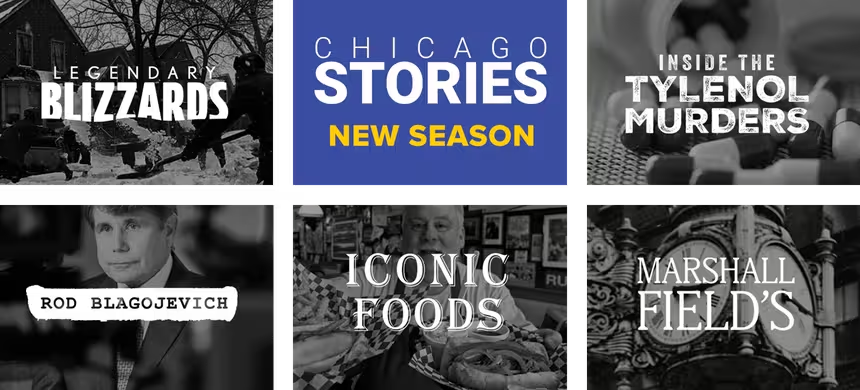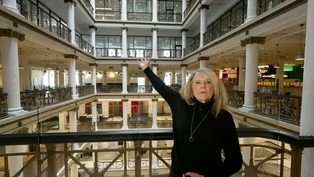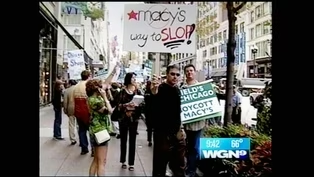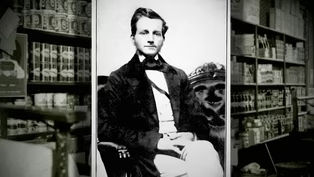Chicago Stories
The Customer Experience at Marshall Field's
Clip: 10/24/2025 | 6m 43sVideo has Closed Captions
Marshall Field’s embodied customer service with the phrase "Give the lady what she wants."
The idea that "the customer is always right" wasn’t always a given. But Marshall Field embedded that into his business model in order to gain customer loyalty.
Problems playing video? | Closed Captioning Feedback
Problems playing video? | Closed Captioning Feedback
Chicago Stories is a local public television program presented by WTTW
Lead support for CHICAGO STORIES is provided by The Negaunee Foundation. Major support is provided by the Abra Prentice Foundation, Inc. and the TAWANI Foundation.
Chicago Stories
The Customer Experience at Marshall Field's
Clip: 10/24/2025 | 6m 43sVideo has Closed Captions
The idea that "the customer is always right" wasn’t always a given. But Marshall Field embedded that into his business model in order to gain customer loyalty.
Problems playing video? | Closed Captioning Feedback
How to Watch Chicago Stories
Chicago Stories is available to stream on pbs.org and the free PBS App, available on iPhone, Apple TV, Android TV, Android smartphones, Amazon Fire TV, Amazon Fire Tablet, Roku, Samsung Smart TV, and Vizio.

Chicago Stories - New Season!
Blizzards that brought Chicago to a standstill. A shocking unsolved murder case. A governor's fall from power. Iconic local foods. And the magic of Marshall Field's legendary holiday windows.Providing Support for PBS.org
Learn Moreabout PBS online sponsorship- [Narrator] Near the turn of the century, the gritty congested streets of downtown Chicago were considered no place for a woman.
- The idea of a woman going into an urban area on her own, especially unescorted, was not something that happened regularly.
- Women didn't go shopping by themselves, their husbands had to go shopping with them.
- [Narrator] Marshall Field saw untapped potential.
He planned to cater to the female shopper.
Rather than buyer beware, Field welcomed women into his store with attentive and courteous service.
- The story goes that Marshall Field oversaw a clerk who was debating with a customer about what she wanted.
- And the employees like, "Well, I'm trying to set her straight."
And he's like, "You'll do no such thing."
- So he said, "Give the lady what she wants."
- [Narrator] Give the lady what she wants.
Those six words were more than just a clever slogan.
They would set a new standard in customer service for the entire industry.
- This whole idea that the customer is always right and we take it for granted, but it wasn't a given in the 19th century.
And for a store to put the customer's needs ahead of its own profits, turns out this is a really good way to build customer loyalty.
- [Narrator] But keeping women in the store long enough to browse and then buy big was another issue all together.
- Women did not have the ability to go out and shop for a full day.
If a woman was hungry and wanted to eat while they were downtown shopping, they would have to go home, or heaven forbid, go to a saloon, which was not a place that ladies would go to eat.
- [Narrator] Rather than lose a lucrative sale, a saleswoman named Mrs.
Herring pitched a delicious lunch solution to one hungry shopper: her homemade chicken pot pie.
- Oh, no, no, you don't have to go.
If you would like, I'll share my lunch with you.
So the sales woman shared her lunch and the woman was thrilled with this, and there was demand to do this again.
- [Narrator] Harry Selfridge, a former stock boy who rose to the head of retail saw a golden opportunity.
Women with leisure time to shop needed a proper place to have lunch.
Selfridge convinced Field to open the store's first tea room, better known today as the iconic Walnut Room, with a menu that still proudly features Mrs.
Herring's original pot pie.
- That was a strategic thing.
There was profit to be made, maybe not directly, but it brought more people into the store and it kept them in the store.
That's a pretty visionary move at a time when most retailers were saying, tough luck, if it's broken, that's on you.
Now, this became more of a destination.
It wasn't just a place to shop, it was a place to be seen.
A place to spend your days.
- [Narrator] Field had transformed the mere errand into an elevated experience.
His global curation staff sourced everything from European fashions to rare antiques direct to the Chicago shopper.
- Part of the way Marshall Field's reputation was spread was by opening buying offices in Paris and London and New York.
- You could find things at Field's that you would not find anywhere else.
- [Narrator] Field did more than source products.
He manufactured them.
He built and bought mills and factories around the country and controlled the supply chain for dozens of exclusive items.
- So they could be competitive in their pricing, know that their product was good, so Marshall Fields was very innovative in doing that in ways that other retailers weren't.
- [Narrator] With a stroke of marketing genius, Field mastered branding, decades before ad agencies coined the term.
- They knew to put their name on everything from a golf ball to a pencil.
(upbeat music) Advertising was the name of the game, and you wanted your name out there.
- [Narrator] And it could all be delivered free, straight to the shopper's doorstep by a fleet of horse-drawn wagons.
- They had at one point something like 700 horses and 400 wagons to cover the entire delivery area, which was like 350 square miles.
- A trip to Field's was so coveted that it came with bragging rights in the form of postcards.
- It was a little like those selfies that we see people taking today from the pyramids and, you know, some of those other exotic locations.
It said something about where someone was.
- [Narrator] Field noticed that his store had become a popular meeting spot, especially at one corner.
- Notes were being left on the corner window at State and Washington for people to return and meet other people as a meetup point.
After all, not everybody had a timepiece at this time, let alone a smartphone, and so rather than have all these notes, he thought by having a clock, people could know what time it is.
- [Narrator] Field envisioned a beacon as beautiful as it was practical.
And in 1897, the Great Clock was installed, 500 pounds of iron that would become a Chicago landmark.
- It became a very popular symbol in Chicago.
And from that day forward, people would say, meet me under the clock.
- [Narrator] Under Field's direction, retail sales skyrocketed from 5 million in 1881 to 68 million in 1906, making him the richest man in Chicago and among the richest in the United States.
Architecture Gems: The Marshall Field and Company Building
Video has Closed Captions
Clip: 10/24/2025 | 5m 2s | Tour some of the architectural gems of the Marshall Field and Company Building. (5m 2s)
The Last Days of Marshall Field's on State Street
Video has Closed Captions
Clip: 10/24/2025 | 6m 15s | In 2006, Marshall Field’s State Street department store officially became Macy’s. (6m 15s)
The Magic of Marshall Field’s Elaborate Displays
Video has Closed Captions
Clip: 10/24/2025 | 9m 27s | Explore the magic of Marshall Field’s elaborate displays – especially at Christmas. (9m 27s)
Video has Closed Captions
Clip: 10/24/2025 | 7m 1s | Meet the man who launched Chicago’s iconic department store. (7m 1s)
Providing Support for PBS.org
Learn Moreabout PBS online sponsorshipSupport for PBS provided by:
Chicago Stories is a local public television program presented by WTTW
Lead support for CHICAGO STORIES is provided by The Negaunee Foundation. Major support is provided by the Abra Prentice Foundation, Inc. and the TAWANI Foundation.



















